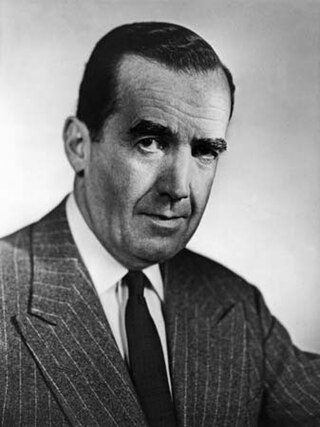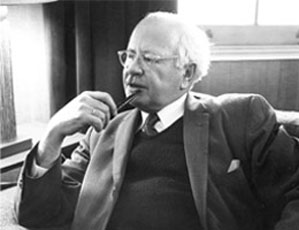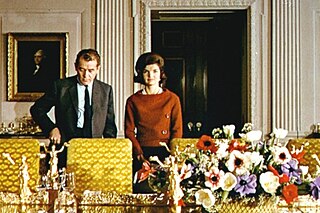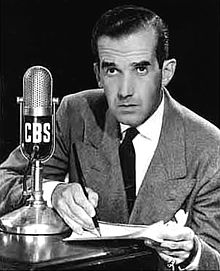
Howard Kingsbury Smith was an American journalist, radio reporter, television anchorman, political commentator, and film actor. He was one of the original members of the team of war correspondents known as the Murrow Boys.

Edward Roscoe Murrow was an American broadcast journalist and war correspondent. He first gained prominence during World War II with a series of live radio broadcasts from Europe for the news division of CBS. During the war he recruited and worked closely with a team of war correspondents who came to be known as the Murrow Boys.
CBS News is the news division of the American television and radio service CBS. CBS News television programs include the CBS Evening News, CBS Mornings, news magazine programs CBS News Sunday Morning, 60 Minutes, and 48 Hours, and Sunday morning political affairs program Face the Nation. CBS News Radio produces hourly newscasts for hundreds of radio stations, and also oversees CBS News podcasts like The Takeout Podcast. CBS News also operates a 24-hour digital news network.

Arnold Eric Sevareid was an American author and CBS news journalist from 1939 to 1977. He was one of a group of elite war correspondents who were hired by CBS newsman Edward R. Murrow and nicknamed "Murrow's Boys." Sevareid was the first to report the Fall of Paris in 1940, when the city was captured by German forces during World War II.

William Lawrence Shirer was an American journalist and war correspondent. He wrote The Rise and Fall of the Third Reich, a history of Nazi Germany that has been read by many and cited in scholarly works for more than 50 years. Originally a foreign correspondent for the Chicago Tribune and the International News Service, Shirer was the first reporter hired by Edward R. Murrow for what became a CBS radio team of journalists known as "Murrow's Boys". He became known for his broadcasts from Berlin, from the rise of the Nazi dictatorship through the first year of World War II (1939–1940). Along with Murrow, he organized the first broadcast world news roundup, a format still followed by news broadcasts.

Charles Collingwood was an American journalist and war correspondent. He was an early member of Edward R. Murrow's group of foreign correspondents that was known as the "Murrow Boys". During World War II, he covered Europe and North Africa for CBS News. Collingwood was also among the early ranks of television journalists who included Walter Cronkite, Eric Sevareid, and Murrow himself.

Robert Trout was an American broadcast news reporter who worked on radio before and during World War II for CBS News. He was regarded by some as the "Iron Man of Radio" for his ability to ad lib while on the air, as well as for his stamina, composure, and elocution.

Cecil Brown was an American journalist and war correspondent who worked closely with Edward R. Murrow during World War II. He was the author of the book Suez to Singapore, which describes the sinking of HMS Repulse in December 1941. He also has a star on the Hollywood Walk of Fame for his contribution to radio.
Laurence Edward LeSueur was an American journalist and a war correspondent during World War II. He worked closely with Edward R. Murrow and was one of the original Murrow Boys.
Richard Curt Hottelet was an American broadcast journalist for the latter half of the twentieth century.

Winston Burdett was an American broadcast journalist and correspondent for the CBS Radio Network during World War II and later for CBS television news. During the war he became a member of Edward R. Murrow's team of war correspondents known as the Murrow Boys. From 1937 to 1942 Burdett was involved with the Communist Party. He testified before the Senate Internal Security Subcommittee in 1955, detailing his espionage work for the Soviet Union in Europe and naming dozens of other party members.
Ned Calmer was a Chicago-born American journalist and writer. He was a long-time CBS News analyst and close associate of Edward R. Murrow.
The CBS World News Roundup is the longest-running network radio newscast in the United States. It airs weekday mornings and evenings on the CBS Radio Network.

William Randall Downs, Jr. was an American broadcast journalist and war correspondent. He worked for CBS News from 1942 to 1962 and for ABC News beginning in 1963. He was one of the original members of the team of war correspondents known as the Murrow Boys.
Thomas Grandin was an American broadcast journalist during World War II. He was an original member of a team of reporters and war correspondents known as the Murrow Boys.
Elizabeth Wason was an American writer and broadcast journalist; a pioneer, with such others as Mary Marvin Breckinridge and Sigrid Schultz, of female journalism in the United States. She worked for and with Edward R. Murrow during World War II, although despite her significant contributions she, along with a handful of other journalists closely associated with Murrow, were rarely recognized in the famed group of war correspondents known as the Murrow Boys. She also wrote numerous books on food and cooking from the 1940s through 1981.

Paul Welrose White was an American journalist and news director who founded the Columbia Broadcasting System's news division in 1933 and directed it for 13 years. His leadership spanned World War II and earned a 1945 Peabody Award for CBS Radio. After his departure from CBS in 1946 he wrote a textbook on broadcast journalism, News on the Air (1947). Since 1956 the Radio Television Digital News Association has presented the Paul White Award for lifetime achievement as its highest honor.

John Hart is a retired American television journalist who worked for several different television networks during the 1960s through the 1990s.
John Franklin MacVane was an American broadcast journalist and war correspondent. He gained prominence covering World War II in Europe for NBC News. Throughout the war he provided eyewitness radio reports on major events, including the London Blitz, the Dieppe Raid, the Allied invasion of Italy, and the Normandy landings at Omaha Beach.











